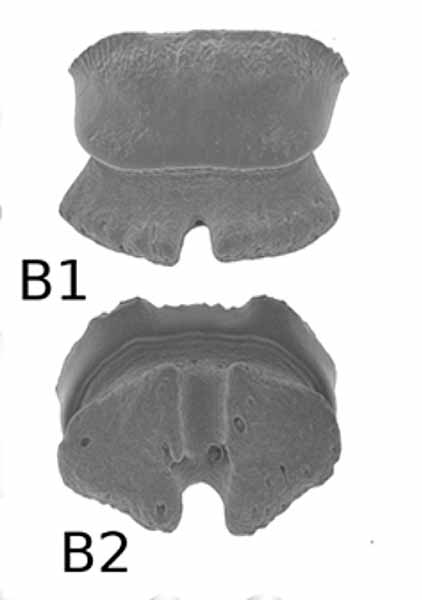†Amamriabatis heni: Unterschied zwischen den Versionen
Es (Diskussion | Beiträge) (→Literatur) |
Es (Diskussion | Beiträge) |
||
| Zeile 11: | Zeile 11: | ||
<!--------------------------- Platz für Abbildungen --------------------------> | <!--------------------------- Platz für Abbildungen --------------------------> | ||
| style="width:50%; padding:0 1em; background:#f5fffa; border:1px solid #ccc;" id=mf-sow| | | style="width:50%; padding:0 1em; background:#f5fffa; border:1px solid #ccc;" id=mf-sow| | ||
| − | + | [[Datei:Amamriabatis heni.jpg|422px|thumb|left|†''Amamriabatis heni'' Holotypus, antero-lateraler Zahn, B1. Okklusale Ansicht, B2. Linguale Ansicht -- (C) {{aut|Adnet}} ''et al.'', 2020 in: ''Palaeontologia Electronica'', '''23''' (2): Article number 23(2):a38.]] | |
|} | |} | ||
== Typen == | == Typen == | ||
| − | '''Holotypus:''' | + | '''Holotypus:''' KEB 1-219 (Abbildung 14B), paleontological collections of the museum of the “Office National des Mines” of Tunis.<br /> |
'''Typusfundort und -schicht:''' Lokalität KEB-1, Djebel el Kébar, Tunesien; Mittleres Eozän (Mittleres Bartonium), Souar-Fortuna-Formationen. | '''Typusfundort und -schicht:''' Lokalität KEB-1, Djebel el Kébar, Tunesien; Mittleres Eozän (Mittleres Bartonium), Souar-Fortuna-Formationen. | ||
Version vom 22. August 2020, 15:13 Uhr
Adnet et al., 2020
|
Familie: Mobulidae |
Typen
Holotypus: KEB 1-219 (Abbildung 14B), paleontological collections of the museum of the “Office National des Mines” of Tunis.
Typusfundort und -schicht: Lokalität KEB-1, Djebel el Kébar, Tunesien; Mittleres Eozän (Mittleres Bartonium), Souar-Fortuna-Formationen.
Etymologie
Benannt zu Ehren von Herrn Kamel Heni, Bürger von Soug-Jedid, für seine beträchtliche Hilfe während der Feldsaison in der Region Djebel el Kébar.
Verbreitung
Mittleres Eozän (Mittleres Bartonium): Tunesien.
Literatur
- Underwood, C.J., Ward, D.J., King, C., Antar, S.M., Zalmout, I.S. & Gingerich, P.D. 2011. Shark and ray faunas in the Middle and Late Eocene of the Fayum Area, Egypt. Proceedings of the Geologists’ Association, 122 (1): 47–66. Zitatseite [: 53-62, fig. 7B, als Burhnamia sp.]
- Merzeraud, G., Essid, E.M., Marzougui, W., Ammar, H.K., Adnet, S., Marivaux, L., Tabuce, R. & Vianey-Liaud, M. 2016. Stratigraphie et sédimentologie des dépôts marins et continentaux d’âge éocène moyen à miocène en Tunisie centrale (région du Djebel el Kébar). Bulletin de la Société géologique de France, 187:11-25. (doi) Zitatseite [: 14-15, tab. 1, als Burhnamia sp.]
- Adnet, S., Marivaux, L., Cappetta, H., Charruault, A.-L., Essid, E.M., Jiquel, S., Ammar, H.K., Marandat, B., Marzougui, W., Merzeraud, G., Temani, R., Vianey-Liaud, M. & Tabuce, R. 2020. Diversity and renewal of tropical elasmobranchs around the Middle Eocene Climatic Optimum (MECO) in North Africa: New data from the lagoonal deposits of Djebel el Kébar, Central Tunisia. Palaeontologia Electronica, 23 (2): Article number 23(2):a38. (doi) Zitatseite [: , !!]
